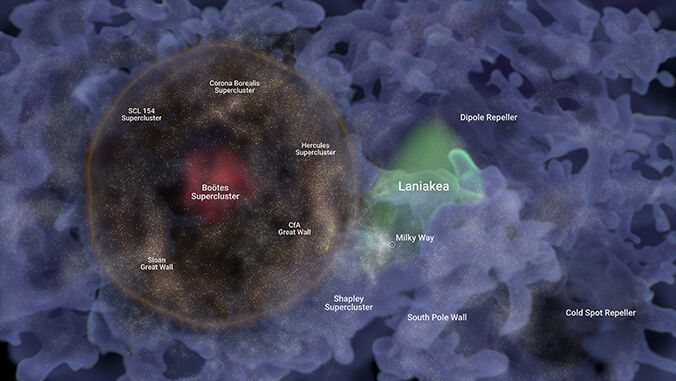
Bubble of galaxies spanning 1 billion light-years could be a fossil of the Big Bang (Image Credit: Space.com)
Astronomers have discovered an immense bubble of galaxies that could be a fossilized remnant leftover from the Big Bang.
The cosmic bubble is located around 820 million light-years from Earth and is a staggering one billion light-years wide. It sits within a web of galaxies and has been given the name “Ho’oleilana,” which is a term from the Hawaiian creation chant Kumulipo. Ho’oleilana describes the origin of structure and relates to the stars and the moon.
Massive structures such as Ho’oleilana are predicted to arise in the universe as a result of tiny ripples in the hot, dense and mostly uniform sea of matter which existed at the beginning of time. These density ripples, called Baryon Acoustic Oscillations (BAOs), grew as the universe underwent a period of rapid inflation (we call that the Big Bang). The ripples are also known to have given rise to major cosmic structures while influencing the distribution of galaxies.
However, this is the first identification of a single structure associated with a BAO.
The bubble itself is composed of previously identified structures that themselves have been considered some of the universe’s largest arrangements of matter. This includes several superclusters, or groups of galaxy clusters, that each contain 10 clusters and span up to 200 million light-years. At the heart of Ho’oleilana lies the Bootes supercluster and the Bootes void, which is a 330 million-light-year-wide space of nothingness.
Related: Galaxy shapes can help identify wrinkles in space caused by the Big Bang
“We were not looking for it. It is so huge that it spills to the edges of the sector of the sky that we were analyzing,” Brent Tully, study leader and an astronomer at the University of Hawaii, said in a statement. “As an enhancement in the density of galaxies, it is a much stronger feature than expected. The very large diameter of one billion light years is beyond theoretical expectations.”
Tully added that if the formation and evolution of Ho’oleilana are in accordance with the Big Bang theory, then the BAO that gave rise to it must be closer to Earth than anticipated and could have implications for how rapidly the universe expanded.
The bubble was found using datasets collected by Cosmicflows-4, which were published in 2022 and marks the largest compilation of precise distances to galaxies.
Tiny oscillations can blow huge cosmic bubbles
Around 380,000 years after the beginning of the universe, space was filled with a sea of electrons and protons. Collectively, this charged particle substance is known as plasma. Eventually, this broiling hot plasma cooled, allowing atoms to form and overly dense regions to collapse under their own gravity. That process was opposed by radiation pushing matter apart, and the cosmic tug of war that ensued between gravity and radiation made the plasma ripple. And these ripples spread outward.
The size of the largest of these ripples were set by the speed at which a soundwave could travel through space’s plasma. This size came out to be around 500 million light-years and, once the plasma had cooled down, left behind vast 3D ripple imprints of sorts.
As the universe aged further, galaxies began to form at density peaks with tremendously wide bubble-like cocoons. That means observing these bubbles via the distributions of galaxies could ultimately help reveal the properties of BAOs.
In 2014, the same team identified the Laniakea Supercluster, which houses the Milky Way (and around 100,000 other galaxies) but is still only 500 million light-years wide, aka half the width of Ho’oleilana. The Laniakea Supercluster runs right to the edge of this larger bubble.
Traces of Ho’oleilana have been discovered before. In 2016, the Sloan Digital Sky Survey identified part of its shell-like structure, but the true extent of its size remained hidden until now. Previous work had also failed to link the cosmic bubble with BAOs.
“I am the cartographer of the group, and mapping Ho’oleilana in three dimensions helps us understand its content and relationship with its surroundings,” Daniel Pomarede, a researcher at the CEA Paris-Saclay University, said in the statement. “It was an amazing process to construct this map and see how the giant shell structure of Ho’oleilana is composed of elements that were identified in the past as being themselves some of the largest structures of the universe.”
The team’s research was published Sept. 5 in The Astrophysical Journal.





